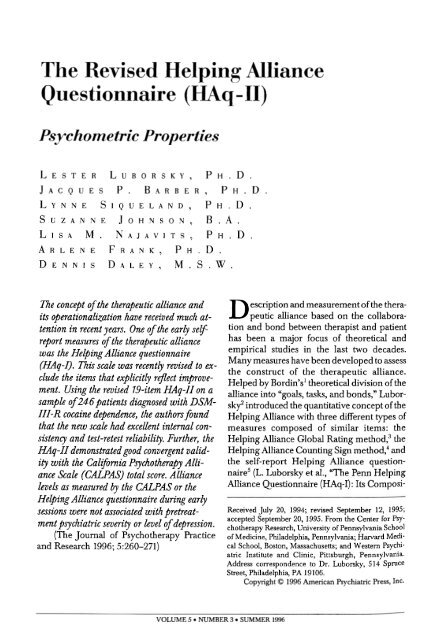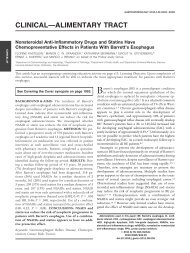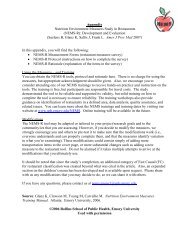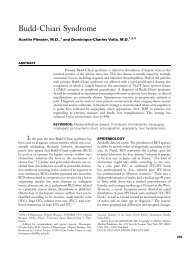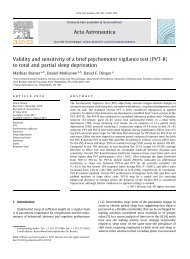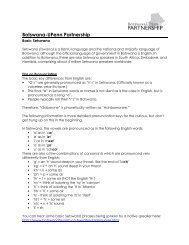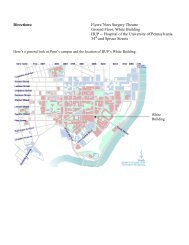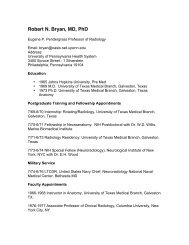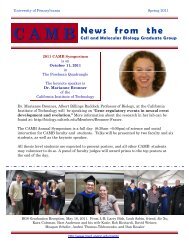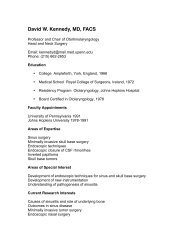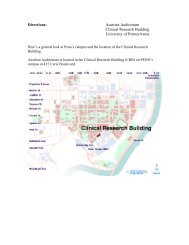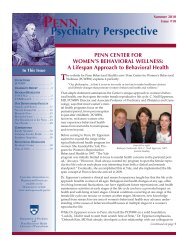The Revised Helping Alliance Questionnaire (HAq-11)
The Revised Helping Alliance Questionnaire (HAq-11)
The Revised Helping Alliance Questionnaire (HAq-11)
Create successful ePaper yourself
Turn your PDF publications into a flip-book with our unique Google optimized e-Paper software.
<strong>The</strong> <strong>Revised</strong> <strong>Helping</strong> <strong>Alliance</strong><br />
<strong>Questionnaire</strong> (<strong>HAq</strong>-<strong>11</strong>)<br />
Pychometric Properties<br />
L E S T E R L U B O R S K Y , PH.D.<br />
J A C Q U E S P. B A R B E R , PH.D.<br />
L Y N N E S I Q U E L A N D , PH.D.<br />
S U Z A N N E J O H N S O N , B . A .<br />
LISA M . N A J A V I T S , PH.D.<br />
A R L E N E F R A N K , PH.D.<br />
D E N N I S D A L E Y , M.S.W.<br />
<strong>The</strong> concept of the therapeutic alliance and<br />
its operationalization have received much at-<br />
tention in recent years. One of the early self-<br />
report measures of the therapeutic alliance<br />
was the <strong>Helping</strong> <strong>Alliance</strong> questionnaire<br />
(<strong>HAq</strong>-I). Tlttk scale was recently revised to ex-<br />
clude the item that explicitly repect improve-<br />
ment. Using the reuired 79-item <strong>HAq</strong>-I1 on a<br />
sample of 246patient-s diagnosed with DSM-<br />
<strong>11</strong>1-R cocaine dependence, the authors found<br />
that the new scale had excellent internal con-<br />
sistency and test-retest reliability. Further, the<br />
<strong>HAq</strong>-I1 demonstrated good convergent valid-<br />
ity with the Calz;fornia Psychotherapy Alli-<br />
ance Scale (CALPAS) total score. <strong>Alliance</strong><br />
levelr as measured by the CALPAS or the<br />
<strong>Helping</strong> <strong>Alliance</strong> questionnaire during early<br />
sessions were not associated with pretreat-<br />
ment psychiatric severity or level of depression.<br />
(<strong>The</strong> Journal of Psychotherapy Practice<br />
and Research 1996; 5:260-271)<br />
VOLUME 5. NUMBER 3 SUMMER 1996<br />
D escription and measurement of the therapeutic<br />
alliance based on the collaboration<br />
and bond between therapist and patient<br />
has been a major focus of theoretical and<br />
empirical studies in the last two decades.<br />
Many measures have been developed to assess<br />
the construct of the therapeutic alliance.<br />
Helped by Bordin's' theoretical division of the<br />
alliance into "goals, tasks, and bonds," Luborsky<br />
introduced the quantitative concept of the<br />
<strong>Helping</strong> <strong>Alliance</strong> with three different types of<br />
measures composed of similar items: the<br />
<strong>Helping</strong> <strong>Alliance</strong> Global Rating method: the<br />
<strong>Helping</strong> <strong>Alliance</strong> Counting Sign meth~d,~ and<br />
the self-report <strong>Helping</strong> <strong>Alliance</strong> question-<br />
naire5 (L. Luborsky et al., "<strong>The</strong> Penn <strong>Helping</strong><br />
<strong>Alliance</strong> <strong>Questionnaire</strong> (<strong>HAq</strong>-I) : Its Composi-<br />
Received July 20, 1994; revised September 12, 1995;<br />
accepted September 20, 1995. From the Center for Psy-<br />
chotherapy Research, University of Pennsylvania School<br />
of Medicine, Philadelphia, Pennsylvania; Harvard Medi-<br />
cal School, Boston, Massachusetts; and Western Psychi-<br />
atric Institute and Clinic, Pittsburgh, Pennsylvania.<br />
Address correspondence to Dr. Luborsky, 514 Spruce<br />
Street, Philadelphia, PA 19106.<br />
Copyright O 1996 American Psychiatric Press, Inc.
tion and Research Supports," submitted for<br />
publication, 1995).<br />
<strong>The</strong> <strong>Helping</strong> <strong>Alliance</strong> methods, as well as<br />
other measures of the therapeutic alliance,<br />
have been successful predictors of outcome.<br />
Summarizing 24 studies, Horvath and Sy-<br />
monds6 showed that the average effect size of<br />
the correlation between alliance and outcome<br />
was estimated as r= 0.26. This was a conser-<br />
vative estimate because the authors consid-<br />
ered all nonsignificant findings where the<br />
value of the correlation was not presented by<br />
the original authors as r = 0.0.<br />
In recent years, we have become aware<br />
that the <strong>HAq</strong>-I was limited by the presence<br />
of items that were explicitly assessing early<br />
symptomatic improvement7'8 and by the fact<br />
that all the items were worded positively. To<br />
address these limitations, we deleted the 6<br />
items reflecting early improvement and<br />
added 14 new items that appeared to tap<br />
more fully the various aspects of the alliance<br />
as described by Bordin' and Luborsky.' Five<br />
of the new items related to the collaborative<br />
effort of patient and therapist; for example,<br />
"<strong>The</strong> therapist and I have meaningful ex-<br />
changes." Five additional items addressed<br />
the patient's perception of the therapist; for<br />
example, "At times I distrust the therapist's<br />
judgment." One of the other added items<br />
dealt directly with the patient's motivation:<br />
"I want very much to work out my prob-<br />
lems"; and one other was related to the<br />
patient's perception of the therapist's feel-<br />
ings about the patient: "I believe that the<br />
therapist likes me as a person." In contrast<br />
to the previous version, the revised <strong>HAq</strong><br />
(hereafter referred to as the <strong>HAq</strong>-<strong>11</strong>) in-<br />
cluded five items that were worded nega-<br />
tively; for example, "<strong>The</strong> procedures used in<br />
my therapy are not well suited to my needs."<br />
In the present article we describe the<br />
psychometric properties of the <strong>HAq</strong>-<strong>11</strong>. We<br />
also examine its relations with another<br />
widely used measure of the alliance, the<br />
California Psychotherapy <strong>Alliance</strong> Scale7>'<br />
(CALPAS) and with selected sociode-<br />
mographic variables.<br />
Subjects<br />
Participants in this study were 246 out-<br />
patients drawn from a total sample of 313<br />
outpatients with a DSM-<strong>11</strong>1-R diagnosis of<br />
cocaine dependence who were randomized<br />
to one of four treatment conditions de-<br />
scribed below as part of their participation<br />
in the training/pilot phase of the National<br />
Institute on Drug Abuse (NIDA) Cocaine<br />
Collaborative Study (CCS). <strong>The</strong> study is co-<br />
ordinated from a center at the University of<br />
Pennsylvania and is being conducted there<br />
and at Brookside Hospital, McLeadMassa-<br />
chusetts General Hospital, and Western Psy-<br />
chiatric Institute and Clinic.<br />
Exclusion criteria included history of bi-<br />
polar disorder, psychotic symptoms or disor-<br />
der, organic brain syndrome, current opioid<br />
dependence, current active suicidal or homi-<br />
cidal potential, medical contraindication, or<br />
homelessness.<br />
At intake, the patients' average age ( + SD)<br />
was 33 + 6.6 years ( range 19-59); 69% of the<br />
patients were male and 31010 were female.<br />
Fifty-six percent were Caucasian, 41% African<br />
American, and 3% Hispanic or American In-<br />
&an. Sixty-one percent of the patients were<br />
employed. Seventy-six percent of the patients<br />
lived alone, and 24% were married or lived<br />
with a partner. Seventy-five percent of the<br />
sample were primarily crack users, 21% were<br />
primarily snorters, and 4% primarily injected<br />
cocaine. On average at the time of intake,<br />
patients were using cocaine 8.9 days per<br />
month and were spending more than $1,000 a<br />
month on drugs. Fifty-two percent of patients<br />
had other substance dependence diagnoses<br />
(mostly alcohol dependence), and 55% had a<br />
personality disorder diagnosis, of which group<br />
20% had antisocial personality disorder. In<br />
addition, 15% of patients had a diagnosis of<br />
current depressive &sorder (9% current major<br />
depression), and 17% had some other Axis I<br />
diagnosis.
Treatment<br />
<strong>The</strong> pilot study was designed to train<br />
therapists and counselors and to finalize the<br />
protocol for a clinical trial to examine the<br />
efficacy of four psychosocial treatments for<br />
outpatients diagnosed with cocaine depen-<br />
dence. <strong>The</strong> treatments were supportive-<br />
expressive dynamic therapy1' (SE), a<br />
psychodynamic treatment based on Lubor-<br />
sky's model;" cognitive therapy1* (CT) based<br />
on Beck's model; individual drug counseling<br />
(IDC) based on the 12-step addiction model<br />
(D. Mercer and G. Woody, unpublished,<br />
1992); and group drug counseling (GDC), a<br />
psychoeducational and problem-solving<br />
group treatment also grounded in the 12-step<br />
addiction model (D. Mercer et al., unpub-<br />
lished, 1994). In the pilot phase, patients were<br />
randomized to one of the treatment conditions<br />
after a brief stabilization phase in which pa-<br />
tients had to establish that they could achieve<br />
a period of initial abstinence measured by 3<br />
consecutive drug-free urine screens within 30<br />
days. All patients in the individual conditions<br />
also received the GDC treatment. Those pa-<br />
tients randomized to the GDC-alone condi-<br />
tion received only the group treatment. Group<br />
sessions were held twice a week for 2 months<br />
and once a week for the next 4 months. <strong>The</strong><br />
active phase of the individual treatment was<br />
also 6 months long and consisted of twice-<br />
weekly sessions for the first 3 months of treat-<br />
ment and once-weekly sessions for months<br />
4-6. Three to six booster sessions were offered<br />
to patients who had stayed in active treatment<br />
for the full 6 months.<br />
<strong>The</strong>rapists and drug counselors had been<br />
selected by their training units on the basis of<br />
a combination of background education and<br />
training, letters of reference, and two audio-<br />
taped samples of their therapy/counseling<br />
work. Educational requirements for SE and<br />
CT therapists were the same (a Ph.D., M.S.W.,<br />
or M.D.), but the experience criteria differed.<br />
SE required 3 to 4 years of postgraduate clini-<br />
cal experience; CT required 6 months of post-<br />
graduate experience for M.S.W.s, 1 year for<br />
VOLUME 5 NUMBER 3 SUMMER 1996<br />
Ph.D.s, or, for M.D.s, 1 year of supervised<br />
individual CT experience during residency.<br />
<strong>The</strong> SE and CT therapists recruited to thls<br />
study had performed an average of 9.9 and<br />
10.6 years of postgraduate clinical work, re-<br />
spectively.<br />
Drug counselors could not exceed certain<br />
levels of qualifications. <strong>The</strong> highest terminal<br />
degree allowable was a bachelor's degree in a<br />
mental health-related field, a counseling cer-<br />
tificate, or a master's degree in addiction coun-<br />
seling (Certified Alcoholism Counselor). All<br />
counselors were required to have 2 to 3 years<br />
of drug counseling experience, and, if in re-<br />
covery themselves, to have at least 5 years in<br />
recovery.<br />
Measures<br />
Beck Depression (BDI). This is a<br />
21-item self-report measure of depression. It is<br />
a much-used, reliable measure of depressive<br />
symptoms. l4<br />
<strong>Helping</strong> <strong>Alliance</strong> questionnaire (<strong>HAq</strong>-<strong>11</strong>).<br />
<strong>The</strong> original <strong>HAq</strong>-15 is a widely used <strong>11</strong>-item<br />
questionnaire that measures the strength of the<br />
patient-therapist therapeutic alliance. To make<br />
up the 19 items of the <strong>HAq</strong>-<strong>11</strong>, 6 items were<br />
removed from the I-IAq-I and 14 new items<br />
were added. Each item is rated on a 6-point<br />
Likert scale (1 = I strongly feel it is not true, 6<br />
= I strongly feel it is true). Both a patient and<br />
a therapist version were developed. Negatively<br />
worded items are reverse scored. <strong>The</strong><br />
patient version is reproduced as Appendix A.<br />
Addiction Severity Index15 (ASI). <strong>The</strong> AS1 is<br />
a structured interview that assesses the patient's<br />
lifetime and current (last 30 days) functioning<br />
in seven target areas related to<br />
substance use: medical status, employment<br />
status, alcohol use, drug use, legal status, psychiatric<br />
status, and family/social relationshps.<br />
<strong>The</strong> measure offers composite scores for each<br />
target area as well as severity ratings. It has<br />
been shown to be reliable and ~alid.'~"~ Test-<br />
retest reliability of 0.83 or higher is reported<br />
on all scales.18 We report here only the drug<br />
use and psychiatric composite scores because
these are prognostic factors that might affect, and suicidality. <strong>The</strong> Ham-D and the SIGH-D<br />
or have been shown to affect, the estab- are standard measures in the field.<br />
lishment of alliance.lg<br />
Global Assessment of F~nctioni4~ (GAF,<br />
BriefSymptom In~ento$~ (BSI). This is a DSM-III-R, Axis V). This is a single global<br />
brief, 53-item version of the self-report Symp- rating scale that takes into account psychologitom<br />
Checklist-90-<strong>Revised</strong>, a measure of psy- cal, social, and occupational functioning. <strong>The</strong><br />
chiatric symptoms. Each item is rated on a GAF is much the same as the older 100-point<br />
5-point Likert scale that ranges from "not at all Health-Sickness Rating Scale,26 but it ranges<br />
distressed" to "extremely distressed." <strong>The</strong> from 0 to 90. <strong>The</strong>se scores reflect low to high<br />
measure yields three global indicators and<br />
nine symptom dimensions. <strong>The</strong> global severlevels<br />
of functioning.<br />
ity index (GSI), the mean of the 53 items, is<br />
used in the current study. Reliability and va-<br />
Procedures<br />
lidity data on the measure are reviewed in Patients filled out the <strong>HAq</strong>-I1 and the<br />
Derogati~.~'<br />
CALPAS at the end of sessions 2, 5, and 24<br />
California Psychotherapy <strong>Alliance</strong>7$ (CAL- and the last session of the active phase of<br />
PAS). This is a 24-item questionnaire with a treatment. <strong>The</strong> therapists filled out the <strong>HAq</strong>-I1<br />
7-point Likert scale (1 = not at all, 7 = very and the CALPAS on the same occasions. <strong>The</strong><br />
much so). <strong>The</strong> CALPAS is composed of four patients also completed the Cocaine Invenscales:<br />
Patient Working Capacity, Patient tory prior to each session and had twice-<br />
Commitment, <strong>The</strong>rapist Understanding and weekly urine screens for drug use. <strong>The</strong> BDI,<br />
Involvement, and Working Strategy Consen- Hamilton, GAF, BSI, and other measures<br />
sus. Like the <strong>HAq</strong>, the CALPAS has both a were administered at intake into the study.<br />
patient and a therapist version. Reliability and A total of 246 patients completed one of<br />
validity are reviewed in Gast~n.~ the alliance measures at least once. As a result,<br />
Cocaine Inventory. This is a measure modi- the n's differ for the different analyses. Exfied<br />
for this study from an unpublished mea- cluded from the sample are 6 patients who had<br />
sure originally designed by Bristol-Myers to change therapists during treatment because<br />
Squibb.22 <strong>The</strong>re are no summary scores for<br />
thls measure, but it consists of the following<br />
questions: how many times she or he has used<br />
cocaine in the last week, how much money<br />
their therapists left the study.<br />
was spent on cocaine in the last week, the Basic descriptive statistics for the alliance meamethod<br />
of administration, and number of sures at the different points in time are pretimes<br />
other drugs were used in the last week. sented in Table 1. One hundred and<br />
In ths study, only the first item was used to ninety-seven patients filled out both the CALreflect<br />
that week's cocaine use.<br />
Hamilton Rating Scale for De~ression~~ <strong>The</strong><br />
PAS-P and the <strong>HAq</strong>-I1 at session 2.<br />
Structured Interview Guide for the Hamilton<br />
Rating Scale for Depression2* (SIGH-D) was<br />
Reliability<br />
used. Although the 27-item version of the in- Internal consistency (Cronbach's alpha)<br />
terview was administered to patients, the of the 19-item <strong>HAq</strong>-I1 and of the CALPAS<br />
scores reported are for the 17 items in the most (total scale) was measured separately for sescommonly<br />
used version of the Hamilton. <strong>The</strong> sions 2, 5, and 24 and was found to reflect<br />
SIGH-D is a structured clinical interview that homogeneous scales (Table 2). For example,<br />
assesses a variety of depressive symptoms, correlations between corrected item and total<br />
including depressed mood, guilt, neurovege- scale for the items of the <strong>HAq</strong>-I1 patient vertative<br />
symptoms, hopelessness, helplessness, sion at session 2 ranged from 0.30 to 0.79.
Only 3 out of 19 correlations were below 0.40,<br />
and the median correlation between corrected<br />
item and total was 0.64. Because patients<br />
sometimes did not complete a particular item<br />
on a scale or subscale, the number of patients<br />
on which the Cronbach's alphas were com-<br />
puted is somewhat lower than the number of<br />
patients presented in Table 1 for all measures.<br />
Test-retest reliability coefficients for all<br />
measures, but especially for the <strong>HAq</strong>-I1 pa-<br />
tient version, were quite high over a three-ses-<br />
sion span from session 2 to session 5 (Table 3).<br />
A mean ( f SD) of 16.3 f 10.3 days elapsed<br />
between these sessions. We also examined the<br />
correlations between the alliance measures<br />
filled out at session 5 and again at session 24.<br />
<strong>The</strong> correlations that are shown in Table 4<br />
provide an index of the stability of the measure<br />
over the relatively long period of time between<br />
those two sessions (a mean of <strong>11</strong>2.3 f 41.1<br />
days). <strong>The</strong> degree of similarity between alli-<br />
ance ratings at session 5 and at session 24 were<br />
quite hgh. Nevertheless, it needs to be empha-<br />
sized that only between 75 and 88 patients and<br />
between 78 and 88 therapists had scores on the<br />
different instruments on these two occasions<br />
because of patient attrition and lack of compli-<br />
- -- -<br />
TABLE 1. Descriptive statistics of the alliance measures at sessions 2,5, and 24<br />
ance with research requests (where patients<br />
and therapists either were not given the forms<br />
or did not fill them out).<br />
Factor Structure<br />
We examined the factorial structure of the<br />
<strong>HAq</strong>-I1 patient version filled out at session 2<br />
by using a principal components analysis with<br />
a varimax rotation. Using the scree test and a<br />
criterion of eigenvalues greater than 1, three<br />
factors were extracted. Because the third factor<br />
consisted of only two items (# <strong>11</strong> and #14) and<br />
explained only 6% of the variance, this factor<br />
was not retained. Factor 1 ("positive therapeu-<br />
tic alliancen) was made up of items 1,2,3,5,<br />
6, 7,9, 10, 12, 13, 15, 17, and 18 and explained<br />
43.3% of the variance. Factor 2 ("negative<br />
therapeutic alliancen) was made up of items 4,<br />
8, 16, and 19 and explained 10.6% of the<br />
variance. At session 2 the correlation between<br />
factors 1 and 2 was found to be r= 0.48 (n =<br />
200, P< 0.001). At session 5, the correlation<br />
was r= 0.60 (n = 182, P< 0.001); at session 24,<br />
r was 0.64 (n= 87, P< 0.001). Because of the<br />
high correlations between these two factors at<br />
the different points in time, the high internal<br />
Variable Session Mean + SD Minimum Maximum n<br />
<strong>HAq</strong>-P 2 5.15 f 0.58 2.1 1 6.00 201<br />
<strong>HAq</strong>-P 5 5.26 f 0.55 3.26 6.00 182<br />
<strong>HAq</strong>-P 24 5.30 k 0.62 1.53 6.00 87<br />
<strong>HAq</strong>-T 2 4.63 k 0.61 2.42 5.95 200<br />
<strong>HAq</strong>-T 5 4.72 f 0.53 3.00 5.95 178<br />
<strong>HAq</strong>-T 24 4.92 k 0.57 3.00 6.00 90<br />
CALPAS-P 2 5.84 f 0.65 3.78<br />
CALPAS-P 5 5.90 + 0.69 3.58<br />
CALPAS-P 24 6.00 k 0.69 3.65<br />
CALPAS-T 2 4.57 f 0.89 1.67<br />
CALPAS-T 5 4.74 f 0.83 2.75<br />
CALPAS-T 24 4.94 f 0.97 2.38<br />
6.96 246<br />
ZOO 213<br />
7.00 92<br />
6.96 246<br />
6.17 206<br />
6.67 93<br />
*Note: <strong>HAq</strong>-P = <strong>Helping</strong> <strong>Alliance</strong> questionnaire-<strong>11</strong>, Patient version; <strong>HAq</strong>-T = <strong>HAq</strong>-<strong>11</strong>, <strong>The</strong>rapist version;<br />
CALPAS-P = California Psychotherapy <strong>Alliance</strong> Scales, Total Scale, Patient version; CALPAS-T = CALPAS,<br />
Total Scale, <strong>The</strong>rapist version.<br />
VOLUME 5 NUMBER 3 SUMMER 1996
consistency of the entire scale, and the small<br />
number of items in factors 2 and 3, only the<br />
results using the entire scale are presented<br />
throughout the rest of this article.<br />
Validity Studies<br />
Convergent Validity With Another Measure of the<br />
<strong>Alliance</strong>: Table 5 shows the correlations be-<br />
tween the <strong>HAq</strong>-I1 and the CALPAS total<br />
scores for both the patient and therapist ver-<br />
sions at sessions 2,5, and 24. Large significant<br />
correlations were found between the two mea-<br />
sures of alliance when filled out by the same<br />
person. <strong>The</strong> correlations between the patient<br />
version of the CALPAS subscales and the<br />
<strong>HAq</strong>-I1 ranged from 0.38 to 0.71, indicating a<br />
fair amount of common variance (ranging<br />
from 35010 to 49010, depending on the subscale<br />
and the session measured). <strong>The</strong> relation be-<br />
tween the therapists' version of the CALPAS<br />
and <strong>HAq</strong>-I1 tended to be slightly higher than<br />
the patients' correlations, ranging from 0.61 to<br />
0.79.<br />
Discriminant Validity: <strong>Alliance</strong> versus sociode-<br />
mographic variables: Correlations between the<br />
dance measwes early in treatment and age,<br />
race, gender, marital status, and employment<br />
were also computed. As expected, no relation<br />
between those variables and either measure of<br />
alliance at session 2 or session 5 was found.<br />
Discriminant Validity: <strong>Alliance</strong> versus pretreat-<br />
ment measures of severity ofpsychiatric dy$nction<br />
and drug use: To examine the discriminant<br />
validity of the alliance and psychiatric sever-<br />
ity, we computed correlations among those<br />
variables. As shown in Table 6, neither mea-<br />
sure of alliance was associated with intake<br />
measures of psychological functioning (GAF),<br />
psychiatric severity (AS1 psychiatric severity<br />
and BSI), drug use (AS1 drug use), or depres-<br />
sion level (Hamilton Depression and BDI).<br />
Because of the number of correlations done,<br />
we corrected the alpha level by dividing it by<br />
12. <strong>The</strong>re was no indication that higher alli-<br />
ance was related to intake measures of symp-<br />
tom severity. Furthermore, inspection of the<br />
data in Table 6 does not reveal any differences<br />
in the patterns of correlations of the <strong>HAq</strong>-I1 or<br />
of the CALPAS.<br />
Discriminant Validity: <strong>Alliance</strong> versus concurrent<br />
measures of severity ofpsychiatric dy$nction and<br />
drug use: To complete this further analysis,<br />
we looked at the symptom measwes that were<br />
available at the time the alliance question-<br />
naires were filled out. <strong>The</strong> only session mea-<br />
sure given to the patient at the same time as<br />
the alliance measure was the Cocaine Inven-<br />
tory. We examined the correlations between<br />
one item on this instrument ("How many times<br />
have you used cocaine in the last week?") and<br />
the respective alliance measures at both ses-<br />
TABLE 2. Internal consistency of Mq-I1 and W A S for patient and therapist versions and their<br />
correlations<br />
Scale Session 2 Session 5 Session 24<br />
*Note: <strong>HAq</strong>-<strong>11</strong>-P = <strong>Helping</strong> <strong>Alliance</strong> questionnaire-<strong>11</strong>, Patient version; <strong>HAq</strong>-<strong>11</strong>-T = <strong>HAq</strong>-<strong>11</strong>, <strong>The</strong>rapist version;<br />
CALPAS-P = California Psychotherapy <strong>Alliance</strong> Scales, Total Scale, Patient version; CALPAS-T = CALPAS,<br />
Total Scale, <strong>The</strong>rapist version.<br />
TOURNAL OF PSYCHOTHERAPY PRACTICE AND RESEARCH
LOO<br />
sion 2 and 5. Because the number of times<br />
cocaine was used was not distributed normally<br />
(many patients had not used in the last week),<br />
we calculated Spearman rank correlations. As<br />
shown in the bottom row of Table 6, we found<br />
that the higher the alliance (as measured by<br />
the <strong>HAq</strong>-I1 and the CALPAS), the lower the<br />
amount of drug use during the same week. <strong>The</strong><br />
correlations were significant for session 5, al-<br />
though not for session 2.<br />
In this report we present psychometric data on<br />
the <strong>HAq</strong>-<strong>11</strong>, an improved version of the <strong>HAq</strong>-I<br />
in composition and length. Both patient and<br />
therapist versions of the new scale showed<br />
good internal consistency and test-retest reli-<br />
ability even though the latter coefficients<br />
might have been reduced by opportunities for<br />
changes in the patient-therapist relationship<br />
occurring in the normal course of treatment.<br />
Long-term stability of the alliance in those<br />
patients who stayed in treatment until at least<br />
session 24 also was found to be adequate<br />
considering the amount of time between the<br />
two sessions.<br />
In terms of convergent validity, the <strong>HAq</strong>-<br />
I1 demonstrated high convergence with an-<br />
other, widely used self-report measure of<br />
alliance, the CALPAS total score (correlations<br />
of 0.59 to 0.69 for the patient version and 0.75<br />
to 0.79 for the therapist version; Table 5). This<br />
was the first demonstration of this agreement;<br />
TABLE 3. Test-retest reliability of the <strong>HAq</strong>-I1 and the W A S over 3 sessions (from session 2 to 5) for<br />
patient and therapist versions -<br />
Scale Patient Version <strong>The</strong>ra~ist Version<br />
CALPAS Total<br />
Patient Working Capacity<br />
Patient Commitment<br />
Working Strategy Consensus<br />
<strong>The</strong>rapist Understanding 0.34 0.59<br />
and Involvement<br />
*No&: <strong>HAq</strong>-I1 = <strong>Helping</strong> <strong>Alliance</strong> questionnaire-<strong>11</strong>; CALPAS = Califomia Psychotherapy AUiance Scales, Total<br />
Scale. All P< 0.001.<br />
TABLE 4. Correlations of the <strong>HAq</strong>-I1 and the W A S between sessions 5 and 24: stability<br />
Scale Patient Version <strong>The</strong>rapist Version<br />
<strong>HAq</strong>-I1 0.34" 0.55"'<br />
(n = 74) (n = 78)<br />
CALPAS Total 0.49'" 0.52"'<br />
(n = 85) (n = 88)<br />
Working Capacity 0.39"' 0.41"'<br />
Patient Commitment 0.52"' 0.54"'<br />
Working Strategies 0.36" 0.48'~'<br />
<strong>The</strong>rapist Understanding 0.28' 0.46"'<br />
-O Note: <strong>HAq</strong>-I1 = <strong>Helping</strong> <strong>Alliance</strong> questionnaire-<strong>11</strong>; CALPAS = California Psychotherapy <strong>Alliance</strong> Scales, Total<br />
Scale.<br />
*P< 0.01; "P< 0.005; "'P< 0.001.<br />
VOLUME 5 NUMBER 3 SUMMER 1996
LUBORSKY ET AL.<br />
an earlier study had reported low convergence<br />
between the <strong>Helping</strong> <strong>Alliance</strong> Rating Scale<br />
and the CALPAS.27 That study, however, used<br />
rater-based methods, rather than self-report, to<br />
assess alliance. It thus seems that, at least in<br />
cocaine-dependent patients. the two self-re-<br />
port measures converge, although further<br />
studies are needed to generalize across clinical<br />
samples. <strong>The</strong> level of convergence is also evi-<br />
dent when comparing the two measures quali-<br />
tatively. Five of the items from each scale are<br />
virtually the same, and several others are very<br />
close in meaning.<br />
One of the most important changes intro-<br />
duced in this new version of the <strong>HAq</strong> is the<br />
attempt to eliminate items that directly reflect<br />
symptomatic improvement.28 Neither of the<br />
alliance measures in the early sessions of ther-<br />
apy was associated with intake measures, indi-<br />
cating that the alliance is not a function of<br />
pretreatment symptomatology. This finding<br />
supports the discriminant validity of both<br />
measures of alliance and is consistent with the<br />
report of Gaston et al.?' who similarly found<br />
a lack of relation between the Hamilton De-<br />
pression Scale and the CALPAS in a group of<br />
elderly depressed patients.<br />
Nevertheless, lower drug use in the pre-<br />
vious week was found to be associated with<br />
relatively better alliance at session 5, although<br />
not at session 2. Because this finding was con-<br />
sistent across both the CALPAS and the <strong>HAq</strong>,<br />
and because the CALPAS has not been criti-<br />
cized as reflecting early improvement, it is our<br />
impression that the present results reflect the<br />
relation between alliance and outcome. This<br />
finding is consistent with Fenichel's3' observa-<br />
tion that greater cocaine use is associated with<br />
poor alliance because drug abusers' involve-<br />
ment with the addictive substance minimizes<br />
meaningful involvement with people.<br />
It may be presumptuous on our part to<br />
expect that alliance measures will be com-<br />
pletely independent from early symptomatic<br />
improvement, since patients are likely to feel<br />
better about the therapist (increased alliance)<br />
when they experience the therapist as helpful<br />
and symptoms are relieved. Moreover, being<br />
helped is likely to generate the expectation<br />
that additional help may be forthcoming.<br />
<strong>The</strong>refore, the best one can hope for in terms<br />
of developing measures of alliance is to mini-<br />
mize items that manifestly reflect early im-<br />
provement. In the present study we have<br />
shown that the pattern of associations between<br />
the <strong>HAq</strong>-I1 and early symptomatic improve-<br />
ment is no different from the pattern of rela-<br />
tions between the CALPAS-P and early<br />
symptomatic improvement. Further, because<br />
alliance is sometimes related to early symp-<br />
tomatic improvement, this covariation has to<br />
be partialed out as Gaston and colleagues did<br />
when predicting o~tcorne.~'<br />
<strong>The</strong> initial results on the validity of the<br />
-- -- - - -- --<br />
TABLE 5. Correlations between <strong>HAq</strong>-I1 and CALPAS subscales and total filled out by patients and<br />
therapists at sessions 2,5, and 24<br />
Session 2 Session 5 Session 24<br />
Patient <strong>The</strong>rapist Patient <strong>The</strong>rapist Patient <strong>The</strong>rapist<br />
Scale (n = 197) (n = 200) (n = 182) (n = 174) (n = 92) (n = 87)<br />
CALPAS scale<br />
Working Capacity 0.43 0.63 0.45 0.64 0.39 0.62<br />
Patient Commitment 0.38 0.74 0.54 0.77 0.59 0.72<br />
Working Strategies 0.57 0.75 0.69 0.68 0.71 0.70<br />
<strong>The</strong>rapist Understanding 0.53 0.64 0.58 0.61 0.63 0.69<br />
CALPAS Total 0.59 0.79 0.68 0.79 0.69 0.75<br />
*Note: <strong>HAq</strong>-I1 = <strong>Helping</strong> <strong>Alliance</strong> questionnaire-<strong>11</strong>; CALPAS = California Psychotherapy <strong>Alliance</strong> Scales, Total<br />
Scale. All P< 0.001.<br />
TIWTRNAT nF PCVPUnTUFR APV PR AFTTPF. AND RFSEARCH
<strong>HAq</strong>-I1 are promising, and we recommend<br />
this version of the alliance measure as an<br />
improvement over the <strong>HAq</strong>-I. Nevertheless,<br />
there are several limitations. Although the<br />
overall patterns of results obtained in the pres-<br />
ent sample of cocaine-dependent patients do<br />
not seem to deviate from results in more "neu-<br />
rotic" samples,28 further experience with the<br />
<strong>HAq</strong>-I1 in nonaddicted patients would in-<br />
crease confidence in the generalizability of the<br />
present findngs. Moreover, the <strong>HAq</strong>-I and<br />
<strong>HAq</strong>-I1 have not yet been administered con-<br />
currently. <strong>The</strong>refore, it cannot be concluded<br />
with confidence that the present version is, in<br />
general, more valid than the older one or,<br />
more specifically, that it reduces the inclina-<br />
tion toward measuring early improvement.<br />
Nevertheless, data from this study suggest that<br />
the <strong>HAq</strong>-I1 provides some improvement in<br />
the measurement of the alliance over the <strong>HAq</strong>-<br />
I, since the pattern of covariation between the<br />
<strong>HAq</strong>-I1 and other variables does not differ<br />
from the pattern of covariation between the<br />
CALPAS-P and other variables.<br />
nk research was supported in part by National<br />
Institute on Drug Abuse Research Scientist Award<br />
2K05 DA00768-24 and by NIDA Grant 5U78<br />
DA07085 (to Lester Luborsky); 5RO7 DA08237<br />
(toJacques P. Barber); and NUrLH Clinical Re-<br />
search Center Grant P50 MH457 78 and Coordi-<br />
nating Center Grant U78-DA07090 (to Paul<br />
Crib- Christoph).<br />
<strong>The</strong> NDA Cocaine Collaborative Study is a<br />
NDA-finded cooperative agreement involvingfour<br />
clinical sites, a coordinating center, and NIDA staff<br />
TABLE 6. Correlations between alliance at session 2 and session 5, as viewed by the patient, and intake<br />
measures of psychiatric severity and concurrent drug use<br />
Measure<br />
Intake measures<br />
AS1 PSYCH<br />
n<br />
AS1 drug use<br />
n<br />
BDI<br />
n<br />
SIGH-D<br />
n<br />
GAF<br />
n<br />
BSI (GSI)<br />
n<br />
Cocaine use<br />
n<br />
W A S <strong>HAq</strong>-I1<br />
Session 2 Session 5 Session 2 Session 5<br />
Concurrent measure of drug use<br />
Times cocaine useda -0.01 -0.21" -0.09 -0.18'<br />
n 214 189 179 163<br />
*Note: <strong>HAq</strong>-II = <strong>Helping</strong> <strong>Alliance</strong> questionnaire-<strong>11</strong>. CALPAS = California Psychotherapy <strong>Alliance</strong> Scales, Total<br />
Scale. AS1 = Addiction Severity Index; PSYCH = Psychiatric severity composite; Drug use = drug use<br />
composite; BDI = Beck Depression Inventory; SIGH-D = Structured Interview Guide for the Hamilton Rating<br />
Scale for Depression; GAF = Global Assessment of Functioning; BSI = Brief Symptom Inventory; GSI =global<br />
severity index; Cocaine use = cocaine use at intake for the last 30 days; Times cocaine used = during last week.<br />
aspearman rank correlation.<br />
'P< 0.05; "P< 0.001.<br />
VOLUME 5 NUMBER 3 SUMMER 1996
LUBORSKY ET AL. 269<br />
<strong>The</strong> coordinating center at the University of Penn-<br />
sylvania, Philadebhia, PA, includes Paul Crits-<br />
Christoph, Ph.D., Princ$al Investigator (PI);<br />
Lynne Siqueland, Ph.D., Project Coordinator;<br />
Karla Moras, Ph.D., Assessment Unit Director;<br />
Jesse Chittams, Ph.D., Director of Data Manage-<br />
ment/Analysis; Larry Muenz, Ph.D., Statistician;<br />
Aaron T. Beck, M.D., and Bruce Liese, Ph.D.,<br />
Headr of Cognitive <strong>The</strong>rapy Training Unit; Lester<br />
Luborsky, Ph.D., and David Mark, Ph.D., Heads<br />
of Supportive-Expressive Training Unit; George<br />
Woody, M.D., and Delinda Mercer, M.A., Heads of<br />
the Drug Counseling/Addiction Recovery Program;<br />
and Delinda Mercer, Denis Daley, and Gloria<br />
Carpenter, Heads of Group Drug Counseling Unit.<br />
R E F E R E N C E S<br />
1. Bordin E: <strong>The</strong> generalizability of the psycho-analytic<br />
concept of the working alliance. Psychotherapy: <strong>The</strong>-<br />
ory, Research and Practice 1979; 16:252-260<br />
2. Luborsky L: <strong>Helping</strong> alliances in psychotherapy: the<br />
groundwork for a study of their relationship to its<br />
outcome, in Successful Psychotherapy, edited by<br />
Claghom JL. New York, Brunner/Mazel, 1976, pp<br />
92-1 16<br />
3. Morgan R, Luborsky L, Crits-Christoph P, et al: Pre-<br />
dicting the outcomes of psychotherapy by the Penn<br />
<strong>Helping</strong> <strong>Alliance</strong> Rating Method. Arch Gen Psychia-<br />
try 1982; 39:397-402<br />
4. Luborsky L, Crits-Christoph P, Alexander L, et al:<br />
Two helping alliance methods for predicting out-<br />
comes of psychotherapy: a counting signs versus a<br />
global rating method. J Nerv Ment Dis 1983; 17 1 :480-<br />
492<br />
5. Luborsky L, McLellan AT, Woody GE, et al: <strong>The</strong>ra-<br />
pist success and its determinants. Arch Gen Psychiatry<br />
1985; 42:602-6<strong>11</strong><br />
6. Horvath AO, Syrnonds BD: Relation between work-<br />
ing alliance and outcome in psychotherapy: a meta-<br />
analysis. Journal of Counseling Psychology 1991;<br />
38:139-149<br />
7. Gaston L: Reliability and criterion-related validity of<br />
the California Psychotherapy <strong>Alliance</strong> Scales-Patient<br />
version. Psychological Assessment 1991; 3:68-74<br />
8. Barber JP, Crits-Christoph P: Development of a<br />
therapist adherence/competence ratings scale for<br />
Supportive-Expressive Dynamic Psychotherapy: a<br />
preliminary report. Psychotherapy Research 1996;<br />
6:79-90<br />
9. Gaston L, Marmar CR: California Psychotherapy Al-<br />
liance Scale, in <strong>The</strong> Working <strong>Alliance</strong>: <strong>The</strong>ory, Re-<br />
search and Practice, edited by Howath A, Greenberg<br />
L, New York, Wiley, 1994, pp 85-108<br />
<strong>The</strong> collaborating staf at NIDA include Jack<br />
Blaine, M.D., and Lisa Onken, Ph.D. T%e four<br />
participating clinical sites are University of Penn-<br />
sylvania, Lester Luborsky, Ph.D. (PI), Jacques P.<br />
Barber, Ph.D. (Co-PI); Brookside Hospital,<br />
Nashua, NH, Arlene Frank, Ph.D. (PI), Steve<br />
Butler (Co-PI); McLean/Massachusetts General<br />
Hospital, Boston, MA, Roger Weiss, M.D. (PI),<br />
David Gaseiend, M.D. (Co-PI); University of<br />
Pittsburgh/Western Psychiatric Institute and<br />
Clinic, Pittsburgh, PA, Michael <strong>The</strong>, M.D. (PI),<br />
Dennis Daley, M.S. W: (Co-PI). <strong>The</strong> contributions<br />
of John Boren, Ph.D., the project oficer for this<br />
cooperative agreement, are also gratefilly acknowl-<br />
edged.<br />
10. Mark D, Faude J: Supportive expressive therapy for<br />
cocaine abuse, in Dynamic <strong>The</strong>rapies for Psychiatric<br />
Disorders (Axis l), edited by Barber JP, Crits-Chris-<br />
toph P. New York, Basic Books, 1995, pp 294-331<br />
1 1. Luborsky L: Principles of Psychoanalytic Psychother-<br />
apy: A Manual for Supportive-Expressive Treatment.<br />
New York, Basic Books, 1984<br />
12. Beck AT, Wright FD, Newman CF, et al: Cognitive<br />
<strong>The</strong>rapy of Substance Abuse. New York, Guilford,<br />
1993<br />
13. Beck T, Ward CH, Mendelson M, et al: An inventory<br />
to measure depression. Arch Gen Psychiatry 1961;<br />
4:561-571<br />
14. Beck AT, Steer RA, Garbin MG: Psychometric prop-<br />
erties of the Beck Depression Inventory: twenty-five<br />
years of evaluation. Clinical Psychology Review 1988;<br />
8:77-100<br />
15. Fureman I, Parikh G, Bragg A, et al: Addiction Sever-<br />
ity Index, 5th edition. Philadelphia, University of<br />
Pennsylvania Veterans Administration Center for<br />
Studies of Addiction, 1990<br />
16. McLellan AT, Luborsky L, CacciolaJ, eta]: New data<br />
from the Addiction Severity Index: reliability and<br />
validity in three centers. J Nerv Ment Dis 1985;<br />
173:412-423<br />
17. Kosten TR, Rounsaville BJ, Kleber HD: Comparison<br />
of clinical ratings to self-reports of withdrawal during<br />
clonidine detoxification of opiate addicts. Am J Drug<br />
Alcohol Abuse 1985; <strong>11</strong>: 1-10<br />
18. McLellan AT, Kushner H, Metzger D, et al: <strong>The</strong> fifth<br />
edition of the Addiction Severity Index. J Subst Abuse<br />
Treat 1992; 9: 199-2 13<br />
19. Luborsky L, BarberJP, Siqueland L, et al: Establishing<br />
a therapeutic alliance with substance abusers. Na-<br />
tional Institute on Drug Abuse Research Monograph<br />
Series (in press)
20. Luborsky L: <strong>The</strong>rapeutic alliances as predictors of<br />
psychotherapy outcomes: factors explaining the pre-<br />
dictive success, in <strong>The</strong> Working <strong>Alliance</strong>: <strong>The</strong>rapy,<br />
Research and Practice, edited by Horvath A, Green-<br />
berg L. New York, Wiley, 1994, pp 38-50<br />
21. Derogatis LR: BSI: Administration, Scoring, and Pro-<br />
cedures Manual-LI, 2nd edition. Towson, MD, Clini-<br />
cal Psychometric Research, 1992<br />
22. Gawin FH, Kleber HD, Byck R, et al: Desipramine<br />
facilitation of initial cocaine abstinence. Arch Gen<br />
Psychiatry 1989; 46: <strong>11</strong>7-121<br />
23. Hamilton MA: A rating scale for depression. J Neurol<br />
Neurosurg Psychiatry 1960; 2356-62<br />
24. Williams JBW: A structured interview guide for the<br />
Hamilton Depression Rating Scale. Arch Gen Psychi-<br />
atry 1988; 45:742-747<br />
25. American Psychiatric Association: Diagnostic and<br />
Statistical Manual of Mental Disorders, 3rd edition,<br />
VOLUME 5 NUMBER 3 SUMMER 1996<br />
revised. Washington, DC, American Psychiatric As-<br />
sociation, 1987<br />
26. Luborsky L, Diguer L, Luborsky E, et al: Psychologi-<br />
cal health as a predictor of outcomes of psychother-<br />
apy. J Consult Clin Psychol 1993; 61:542-548<br />
27. Tichenor V, Hill CE: A comparison of six measures<br />
of working alliance. Psychotherapy 1989; 26: 195-199<br />
28. Gaston L, Marmar CR, Gallagher D, et al: <strong>Alliance</strong><br />
prediction of outcome beyond in-treatment syrnptom-<br />
atic change as psychotherapy processes. Psychother-<br />
apy Research 1991; 1: 104-1 13<br />
29. Gaston L, Marmar CR, Thompson LW, et al: Relation<br />
of patient pretreatment characteristics to the therapeu-<br />
tic alliance in diverse psychotherapies. J Consult Clin<br />
Psychol 1988; 56:483-489<br />
30. Fenichel 0: <strong>The</strong> Psychoanalytic <strong>The</strong>ory of Neuroses.<br />
New York, WW Norton, 1945<br />
A
Appendiv A. <strong>Helping</strong> <strong>Alliance</strong> <strong>Questionnaire</strong>, Patient Version<br />
Instructions: <strong>The</strong>se are ways that a person may feel or behave in relation to another<br />
persodeir therapist. Consider carefully your relationship with your therapist, and then<br />
mark each statement according to how strongly you agree or disagree. Please mark every one.<br />
1. I feel I can depend upon the therapist<br />
2. I feel the therapist understands me.<br />
3. I feel the therapist wants me to<br />
achieve my goals.<br />
4. At times I distrust the therapist's<br />
judgment<br />
5. I feel I am working together with<br />
the therapist in a joint effort.<br />
6. I believe we have similar ideas<br />
about the nature of my problems.<br />
% I generally respect the therapist's<br />
views about me.<br />
8. <strong>The</strong> procedures used in my therapy<br />
are not well suited to my needs.<br />
9. I like the therapist as a person.<br />
10. In most sessions, the therapist and<br />
I find a way to work on my<br />
problems together.<br />
<strong>11</strong>. <strong>The</strong> thera~ist relates to me in wa s<br />
that slow up the progress of the &erapy.<br />
12. A ood relationship has formed<br />
wig my therapist.<br />
13. <strong>The</strong> therapist appears to be<br />
experienced in helping people.<br />
14. I want very much to work out my<br />
problems.<br />
15. <strong>The</strong> therapist and I have<br />
meaningful exchanges.<br />
16. <strong>The</strong> therapist and I sometimes<br />
have unprofitable exchanges.<br />
1% From time to time, we both talk about<br />
the same important events in my past<br />
18. I believe the therapist likes me as a<br />
person.<br />
19. At times the therapist seems distant<br />
Strongly<br />
Disagree<br />
1<br />
1<br />
1<br />
1<br />
1<br />
1<br />
1<br />
1<br />
1<br />
1<br />
1<br />
1<br />
1<br />
1<br />
1<br />
1<br />
1<br />
1<br />
1<br />
Di<br />
2<br />
2<br />
2<br />
2<br />
2<br />
2<br />
2<br />
2<br />
2<br />
2<br />
2<br />
2<br />
2<br />
2<br />
2<br />
2<br />
2<br />
2<br />
2<br />
Slightly Slightly<br />
Disagree Agree<br />
3<br />
3<br />
3<br />
3<br />
3<br />
3<br />
3<br />
3<br />
3<br />
3<br />
3<br />
3<br />
3<br />
3<br />
3<br />
3<br />
3<br />
3<br />
3<br />
4<br />
4<br />
4<br />
4<br />
4<br />
4<br />
4<br />
4<br />
4<br />
4<br />
4<br />
4<br />
4<br />
4<br />
4<br />
4<br />
4<br />
4<br />
4<br />
Agree<br />
5<br />
5<br />
5<br />
5<br />
5<br />
5<br />
5<br />
5<br />
5<br />
5<br />
5<br />
5<br />
5<br />
5<br />
5<br />
5<br />
5<br />
5<br />
5<br />
Strongly<br />
Agree<br />
6<br />
6<br />
6<br />
6<br />
6<br />
6<br />
6<br />
6<br />
6<br />
6<br />
6<br />
6<br />
6<br />
6<br />
6<br />
6<br />
6<br />
6<br />
6


